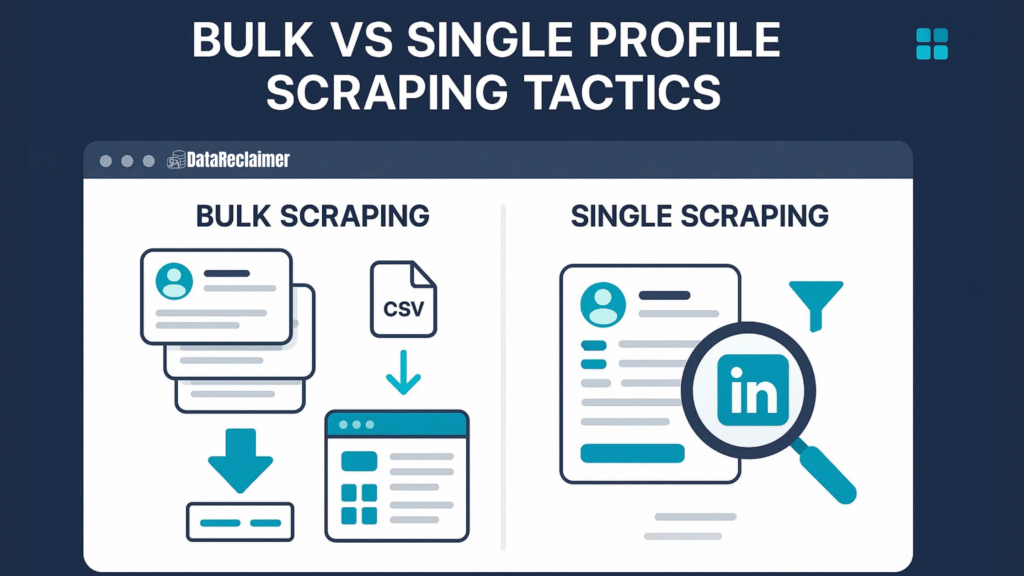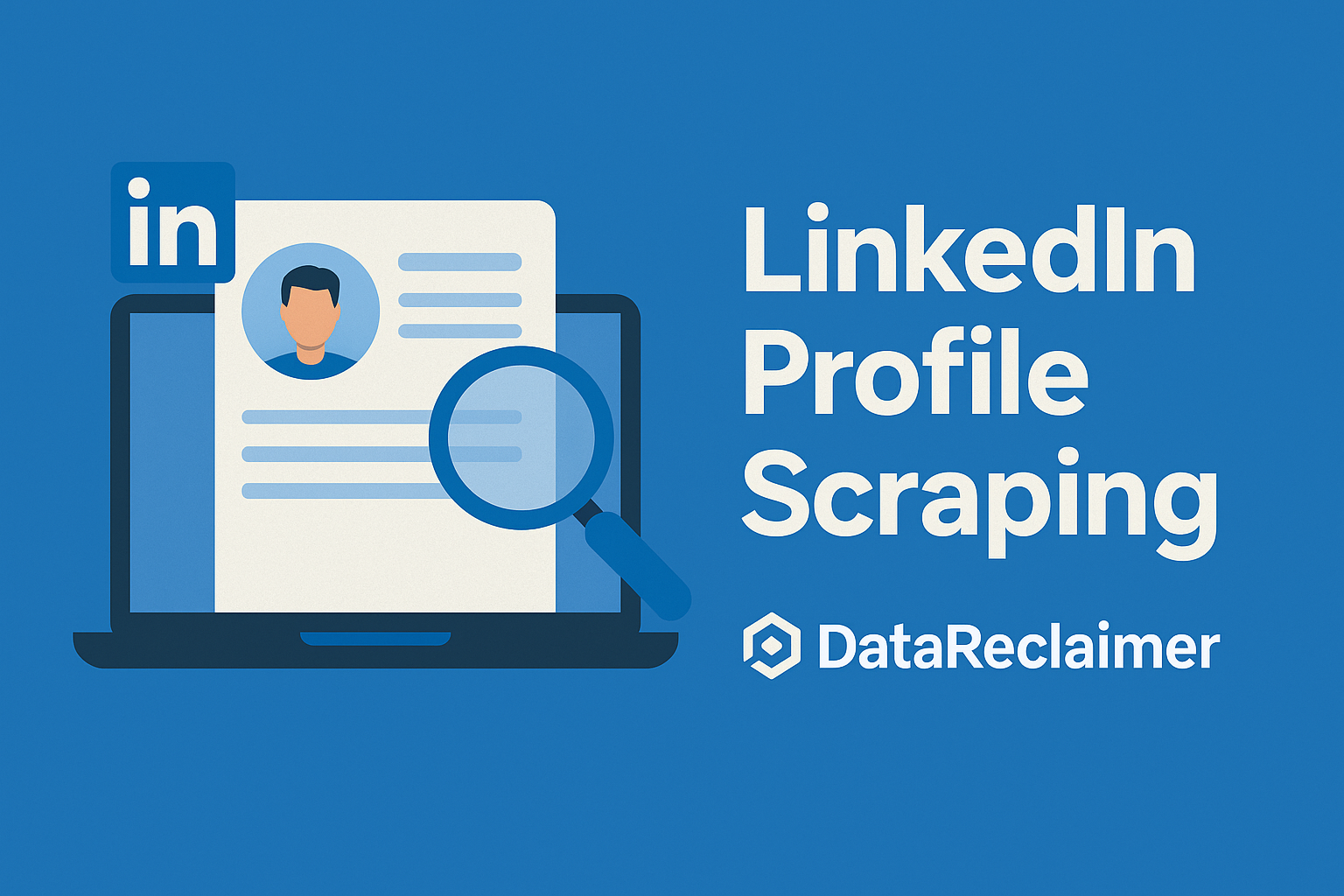
As the B2B landscape continues to evolve, more and more sales teams, recruiters, and marketers are leveraging powerful scraping tools for their outbound campaigns and talent acquisition strategies. Choosing between bulk and single profile scraping methods can make all the difference in the world. Understanding the difference between these two approaches is more than just determining which is faster. It’s about data quality, adherence to laws, and ultimately your bottom line.
In 2025, with LinkedIn’s growing AI detection systems and the more stringent privacy regulations, it’s more important than ever to choose the right approach. This ultimate guide will break down the benefits of each approach and the differences between bulk and single linkedin profile scraping. We’ll also discuss how DataReclaimer’s ethical data enrichment can help streamline your scraping process and provide you with cleaner, more secure, and more effective leads.
What Is LinkedIn Profile Scraping?
LinkedIn profile scraping is the collection of professional data, such as name, title, company, and contact information, from LinkedIn profiles for business use. LinkedIn profile scraping is often used for lead generation by building lists of prospects, for recruiting by finding candidates, and by sales automation tools to fill CRM systems with new contact information.
There are two main categories of LinkedIn profile scraping. Single profile scraping is performed manually, carefully extracting individual information from each profile; while bulk profile scraping uses automated software to quickly gather large amounts of information from many profiles.
Read More: Best 15 Scraping Tools for Linkedin

Single Profile Scraping: Tactic Overview
Single profile scraping involves the manual or semi-automated collection of information from individual LinkedIn profiles, typically one at a time. This approach prioritises quality over quantity, allowing for careful validation and personalised data collection.
Advantages of Single Profile Scraping
- Enhanced Accuracy: When you focus on one profile at a time, you can verify information accuracy immediately. This means fewer bounced emails, incorrect job titles, or outdated company information in your prospect database.
- Superior Personalisation Opportunities: Single profile scraping allows you to gather contextual information that bulk methods might miss. You can note recent posts, mutual connections, or specific interests that enhance your outreach personalisation.
- Reduced Detection Risk: LinkedIn automation risks are significantly lower when you’re not hammering their servers with hundreds of requests. This manual approach mimics natural browsing behaviour, making it less likely to trigger security measures.
Disadvantages of Single Profile Scraping
- Time-Intensive Process: The most obvious drawback is speed. Collecting information from individual profiles can take several minutes per contact, making it impractical for large-scale campaigns.
- Limited Scalability: If your sales team needs thousands of prospects monthly, single profile scraping simply cannot meet those volume requirements efficiently.
- Inconsistency Risk: Different team members might collect varying types of information, leading to incomplete or inconsistent data sets that require additional standardisation.
Ideal Use Cases for Single Profile Scraping
This technique is effective for high-ticket B2B sales cycles where relationship quality is more important than volume. Executive targeting campaigns, venture capital prospecting, and specialized recruiting for C-level roles all benefit from the more targeted, personalized efforts enabled by single profile scraping.
Bulk Profile Scraping: Tactic Overview
Bulk profile scraping utilises B2B data scraping methods to collect information from hundreds or thousands of LinkedIn profiles simultaneously. This approach prioritises scale and efficiency, making it possible to build extensive prospect databases quickly.
Advantages of Bulk Profile Scraping
- Speed and Scale: The primary benefit is obvious—you can collect vast amounts of data in a fraction of the time required for manual methods. Some tools can process hundreds of profiles per hour.
- Campaign Efficiency: For lead generation scraping tools focused on top-of-funnel activities, bulk scraping provides the volume necessary to support multiple campaigns and A/B testing initiatives.
- Cost-Effective for Large Teams: When you need to support multiple SDRs or recruiters, bulk scraping can provide a steady stream of prospects without dedicating significant manual resources.
Disadvantages of Bulk Profile Scraping
- Data Quality Concerns: Automated collection often results in incomplete profiles, outdated information, or irrelevant contacts that require extensive cleaning before use.
- Increased LinkedIn Restrictions: Bulk scraping significantly increases your LinkedIn automation risks. The platform’s algorithms are designed to detect and restrict accounts engaging in large-scale automated activities.
- Generic Data Sets: The information collected through bulk methods often lacks the contextual details that make personalised outreach effective, potentially reducing campaign performance.
Ideal Use Cases for Bulk Profile Scraping
Bulk scraping works well for a scenario where large quantities of prospects are needed to test and optimize. SDRs running multiple campaigns, recruiters hiring many people, and marketers building massive email lists all need bulk.
Key Differences: Bulk vs Single Profile Scraping
| Feature | Bulk Scraping | Single Profile Scraping |
| Speed | Fast, hundreds per hour | Slow, manual or limited automation |
| Accuracy | Lower accuracy, more junk data | Higher accuracy, verified by user |
| Personalisation | Low or generic | High personalisation possible |
| Tool Risk | Higher (LinkedIn detection likely) | Lower (if done responsibly) |
| Use Cases | B2B outreach, recruitment at scale | Executive targeting, high-touch sales |
| Data Volume | Thousands of profiles | Dozens to hundreds |
| Quality Control | Post-processing required | Real-time validation |
| Compliance Risk | Higher due to volume | Lower with careful execution |
Legal & Compliance Considerations
As of 2021, there are very strict guidelines on what is and is not allowed in terms of scraping information. LinkedIn is strict on the use of software to collect information from their platform. In the LinkedIn Terms of Service, automated scraping is specifically prohibited. You can have your LinkedIn account blocked or even face legal action for scraping without explicit authorization from LinkedIn. However, when it comes to public information that does not require authentication, and/or does not infringe on a person’s privacy settings, you can scrape to your heart’s content.
Additional Regulations: While complying with LinkedIn’s Terms of Service is critical, other laws, such as GDPR, CCPA, and the India Personal Data Protection Act are also critical to consider. Collecting data, storing it, and using it is a regulated activity in many jurisdictions.
DataReclaimer’s Compliant Approach: DataReclaimer prioritizes legal compliance by accessing only public sources and avoiding login-based scraping of LinkedIn. We focus on data enrichment and validation, not collection, to help mitigate legal risks while improving data quality.
By taking this approach, we allow your lead generation process to be compliant while delivering clean, high-quality data that your sales teams need.
Choosing the Right Tactic for Your Use Case
Selecting between bulk and single profile scraping requires careful consideration of your specific business needs and constraints.
- Volume Requirements: How many prospects do you need monthly? If you’re targeting hundreds of executive-level contacts, single profile scraping might suffice. If you need thousands for multiple campaigns, bulk methods become necessary.
- Personalisation Depth: Do you need detailed background information for highly personalised outreach, or are job title and company sufficient for your campaigns?
- Risk Tolerance: How comfortable are you with potential LinkedIn account restrictions? Higher volume scraping increases detection risks.
- Campaign Duration: Are you nurturing long-term, high-value relationships or running high-velocity, short-cycle campaigns?
Your answers to these questions will guide your tactical choice and help you avoid common pitfalls in lead generation scraping tools implementation.
Hybrid Approach: Best of Both Worlds
The most sophisticated prospecting teams don’t choose between bulk and single profile scraping—they use both strategically. This hybrid approach maximises efficiency whilst maintaining data quality where it matters most.
The Hybrid Workflow:
Start with bulk scraping to build your initial prospect universe. This gives you a broad base of potential contacts across your target criteria.
Import this data into DataReclaimer for cleaning and enrichment. Our platform removes duplicates, validates email addresses, and enriches missing information.
Segment your cleaned list by priority. High-value prospects get individual attention, whilst broader campaigns can proceed with the bulk data.
Apply single profile research to your top-tier prospects. This might be the top 10% of your list based on company size, role seniority, or strategic importance.
Launch personalised campaigns to your researched prospects whilst running broader campaigns to the remaining segments.
This approach gives you the volume benefits of bulk scraping with the quality advantages of individual research where it creates the most impact.
How DataReclaimer Optimises Both Tactics
DataReclaimer serves as the crucial bridge between raw scraped linkedin data and actionable prospect intelligence. Our platform addresses the common weaknesses in both scraping approaches whilst amplifying their strengths.
- Data Validation and Enrichment: We validate email addresses, update job titles, and enrich missing contact information, turning incomplete bulk data into reliable prospect records.
- Intelligent Segmentation: Our tagging and segmentation features help you categorise contacts by industry, role, company size, and other criteria, making both bulk and single profile data more actionable.
- Duplicate Detection: Whether you’re combining data from multiple sources or cleaning a single large import, our duplicate detection ensures your database remains clean and efficient.
- Compliance-First Approach: By focusing on enrichment rather than scraping, DataReclaimer helps you maintain data compliance whilst improving prospect quality.
- Export Optimisation: Our platform prepares your data for immediate use in your preferred outreach tools, eliminating the manual work typically required after scraping.
Conclusion: The Smart Scraper’s Advantage in 2025
There’s no “right” answer to this question — neither is “wrong.” The future of LinkedIn prospecting is about deciding when to use which strategy, not which one to choose.
If you understand the pros and cons of both approaches, you’ll become a savvy team capable of achieving amazing things. What matters most is that you’re complying with the latest privacy regulations and using best practices to cleanse and enrich your prospects’ information.
The end goal is to generate higher-quality leads, and as a result, stronger connections. Whether you decide to use bulk or single profile scraping, it’s ultimately how you follow up with your prospects that will make or break your success.
Ready to upgrade your scraping strategy with data from a cleaner, safer, and smarter approach to LinkedIn prospecting? Try DataReclaimer today.
Frequently Asked Questions
Is bulk LinkedIn scraping safe in 2025?
Bulk scraping carries higher risks than ever due to LinkedIn’s enhanced detection systems. Use tools like DataReclaimer for post-scraping validation and keep automation minimal to reduce account restriction risks.
Can single profile scraping avoid LinkedIn restrictions?
Yes, single profile scraping has much lower detection risks, especially when combined with natural browsing patterns and responsible data collection practices that don’t overwhelm LinkedIn’s servers.
What tools support compliant scraping tactics?
Choose tools that work with public data and avoid logging in on your behalf. DataReclaimer supports compliant enrichment, cleaning, and segmentation without direct LinkedIn scraping.
Should I mix bulk and single profile tactics?
Absolutely. Use bulk scraping for initial list building and single-profile research for high-value prospect personalisation. This hybrid approach maximises both efficiency and conversion rates.
How does DataReclaimer improve scraping data quality?
DataReclaimer validates email addresses, enriches missing job information, segments contacts intelligently, and removes outdated leads—transforming scraped data into reliable, outreach-ready prospect databases.

CEO @ Growwitharora | CoFounder @DataReclaimer | Outstanding Leadership award winner | PMP® Certified | Growth Strategist | | $3M+ Invested in Paid Ads | SaaS
